Related Research Articles

Crocodiles or true crocodiles are large semiaquatic reptiles that live throughout the tropics in Africa, Asia, the Americas and Australia. The term crocodile is sometimes used even more loosely to include all extant members of the order Crocodilia, which includes the alligators and caimans, the gharial and false gharial among other extinct taxa.
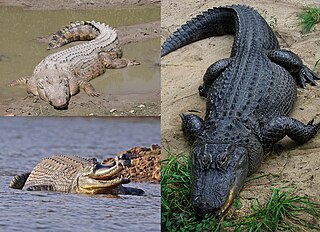
Crocodilia is an order of mostly large, predatory, semiaquatic reptiles known as crocodilians. They first appeared 94 million years ago in the Late Cretaceous period and are the closest living relatives of birds, as the two groups are the only known survivors of the Archosauria. Members of the order's total group, the clade Pseudosuchia, appeared about 250 million years ago in the Early Triassic period, and diversified during the Mesozoic era. The order Crocodilia includes the true crocodiles, the alligators and caimans, and the gharial and false gharial. Although the term crocodiles is sometimes used to refer to all of these, crocodilians is a less ambiguous vernacular term for members of this group.

The saltwater crocodile is a crocodilian native to saltwater habitats, brackish wetlands and freshwater rivers from India's east coast across Southeast Asia and the Sundaic region to northern Australia and Micronesia. It has been listed as Least Concern on the IUCN Red List since 1996. It was hunted for its skin throughout its range up to the 1970s, and is threatened by illegal killing and habitat loss. It is regarded as dangerous to humans.
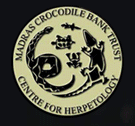
The Madras Crocodile Bank Trust and Centre for Herpetology (MCBT) is a reptile zoo and herpetology research station, located 40 kilometres (25 mi) south of the city of Chennai, in state of Tamil Nadu, India. The centre is both a registered trust and a recognized zoo under the Wildlife (Protection) Act, 1972 and comes under the purview of the Central Zoo Authority, Ministry of Environment, Forest and Climate Change, Government of India. It was established with the aim of saving three Indian endangered species of crocodile—the marsh or mugger crocodile, the saltwater crocodile, and the gharial, which at the time of founding of the trust were all nearing extinction.

The Nile crocodile is a large crocodilian native to freshwater habitats in Africa, where it is present in 26 countries. It is widely distributed in sub-Saharan Africa, occurring mostly in the eastern, southern, and central regions of the continent, and lives in different types of aquatic environments such as lakes, rivers, swamps, and marshlands. Although capable of living in saline environments, this species is rarely found in saltwater, but occasionally inhabits deltas and brackish lakes. The range of this species once stretched northward throughout the Nile River, as far north as the Nile Delta. Generally, the adult male Nile crocodile is between 3.5 and 5 m in length and weighs 225 to 750 kg. However, specimens exceeding 6.1 m (20 ft) in length and 1,000 kg (2,200 lb) in weight have been recorded. It is the largest freshwater predator in Africa, and may be considered the second-largest extant reptile in the world, after the saltwater crocodile. Size is sexually dimorphic, with females usually about 30% smaller than males. The crocodile has thick, scaly, heavily armoured skin.

The American crocodile is a species of crocodilian found in the Neotropics. It is the most widespread of the four extant species of crocodiles from the Americas, with populations present from South Florida and the coasts of Mexico to as far south as Peru, Ecuador, Colombia, and Venezuela.
Zoosadism is sexual pleasure derived from cruelty to animals. It is a paraphilia, where zoosadists are sexually aroused by pain inflicted on animals. Zoosadism is part of the Macdonald triad, a set of three behaviors that are considered a precursor to psychopathic behavior.

The freshwater crocodile, also known as the Australian freshwater crocodile, Johnstone's crocodile or the freshie, is a species of crocodile endemic to the northern regions of Australia. Unlike their much larger Australian relative, the saltwater crocodile, freshwater crocodiles are not known as man-eaters, although they bite in self-defence, and brief, nonfatal attacks have occurred, apparently the result of mistaken identity.

The Siamese crocodile is a medium-sized freshwater crocodile native to Indonesia, Brunei, East Malaysia, Laos, Cambodia, Myanmar, Thailand and Vietnam. The species is critically endangered and already extirpated from many regions. Its other common names include Siamese freshwater crocodile, Singapore small-grain, and soft-belly.
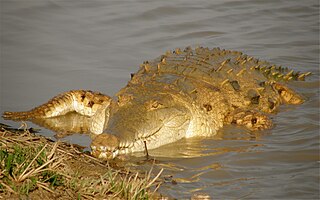
The Orinoco crocodile is a critically endangered crocodile. Its population is very small, and they can only be found in the Orinoco river basin in Venezuela and Colombia. Extensively hunted for their skins in the 19th and 20th centuries, it is one of the most endangered species of crocodiles. It is a very large species of crocodilian; males have been reported up to 6.8 m in the past, weighing over 900 kg (2,000 lb), but such sizes do not exist today, 5.2 m being a more widely accepted maximum size. A large male today may attain 4.2 m in length and can weigh up to 450 kg (1,000 lb), while females are substantially smaller with the largest likely to weigh around 225 kg (496 lb). Sexual dimorphism is not as profound as in other crocodilian species. The coloration is light even in adults.

The Philippine crocodile, also known as the Mindoro crocodile, the Philippine freshwater crocodile, the bukarot in Ilocano, and more generally as a buwaya in most Filipino lowland cultures, is one of two species of crocodiles found in the Philippines; the other is the larger saltwater crocodile (Crocodylus porosus). The Philippine crocodile, the species endemic only to the country, went from data deficient to critically endangered in 2008 from exploitation and unsustainable fishing methods, such as dynamite fishing. Conservation methods are being taken by the Dutch/Filipino Mabuwaya foundation, the Crocodile Conservation Society and the Zoological Institute of HerpaWorld in Mindoro island. It is strictly prohibited to kill a crocodile in the country, and it is punishable by law.

Crocodile attacks on humans are common in places where large crocodilians are native and human populations live. It has been estimated that about 1,000 people are killed by crocodilians each year.
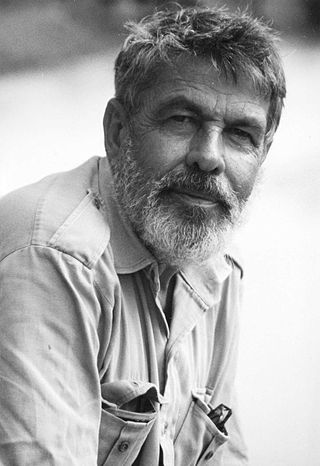
Tony Charles (Mashesha) Pooley (1938–2004) was a South African naturalist, award-winning conservationist and one of the world's foremost authorities on the Nile crocodile.

Morelet's crocodile, also known as the Mexican crocodile or Belize crocodile, is a modest-sized crocodilian found only in fresh waters of the Atlantic regions of Mexico, Belize and Guatemala. It usually grows to about 3 metres (10 ft) in length. It is a Least Concern species. The species has a fossil record in Guatemala.

Sweetheart was the name given to a 5.1 m (17 ft) male saltwater crocodile which Northern Territory folk legend claims was responsible for a series of attacks on boats in Australia in the 1970s.

Wildlife attacks in Australia occur every year from several different native species, including snakes, spiders, freshwater and saltwater crocodiles, various sharks, cassowaries, kangaroos, stingrays and stonefish and a variety of smaller marine creatures such as bluebottles, blue-ringed octopus, cone shells and jellyfish.

The Cuban crocodile is a small-medium species of crocodile endemic to Cuba. Typical length is 2.1–2.3 m (6.9–7.5 ft) and typical weight 70–80 kg (150–180 lb). Large males can reach as much as 3.5 m (11 ft) in length and weigh more than 215 kg (474 lb). Despite its smaller size, it is a highly aggressive animal, and potentially dangerous to humans.
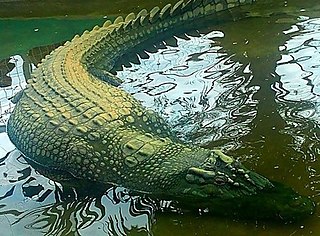
Lolong was the largest crocodile in captivity. He was a saltwater crocodile measured at 6.17 m, and weighed 1,075 kg (2,370 lb), making him one of the largest crocodiles ever measured from snout-to-tail.

The West African crocodile, desert crocodile, or sacred crocodile is a species of crocodile related to — and often confused with — the larger and more aggressive Nile crocodile.
Adam Robert Corden Britton is a British crocodile expert and zoosadist who in September 2023 was charged with 60 offenses relating to sexual abuse and torture of animals and possession of child abuse material. He has pled guilty to the charges.
References
- ↑ "Adam Britton - Profile @RIEL". riel.cdu.edu.au. Charles Darwin University . Retrieved 1 June 2016.
- ↑ "Academic Profile" . Retrieved 1 June 2016.
- ↑ "Erin Britton - profile". www.expeditions.com. Retrieved 1 June 2016.
- ↑ "Croc attacks: a new website with bite". www.theconversation.com. 3 Dec 2013.
- ↑ Milman, Oliver (25 Nov 2014). "Crocodile attack database 'will aid conservation efforts and save lives'". The Guardian .
- 1 2 "CrocBITE - Acknowledgments". www.crocodile-attack.info. Retrieved 30 May 2016.
- 1 2 Gallagher, Laura (12 Dec 2014). "Crocodile attack project could help save lives in vulnerable communities". Imperial College London .
- ↑ "Frequently Asked Questions - CrocBITE". www.crocodile-attack.info. Retrieved 30 May 2016.
- ↑ McCafferty, Georgia (30 May 2016). "Australian MP blames 'human stupidity' for suspected fatal croc attack". CNN .
- ↑ "Adam Britton: British croc expert admits sexually abusing dogs". BBC news.
- ↑ "NT crocodile expert who once hosted David Attenborough pleads guilty to animal sexual abuse". The Guaidan.